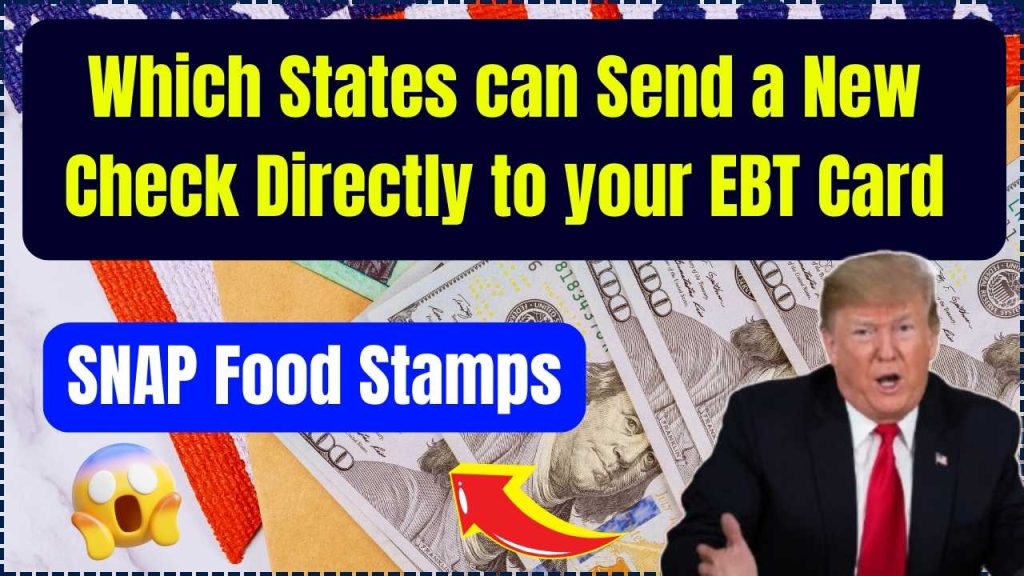
Which states can send a new check directly to your EBT card: The Supplemental Nutrition Assistance Program (SNAP), commonly known as food stamps, is a crucial support system for millions of Americans facing food insecurity. Each state administers SNAP according to federal guidelines, but some have unique policies, including initiatives to provide extra benefits in times of hardship.
Understanding how these benefits work, and whether your state offers additional payments or new checks to your Electronic Benefit Transfer (EBT) card, can make a significant difference for those relying on this program.
In this article, we’ll break down which states can send new checks, how to check your benefits, and other steps to ensure you’re getting the most from SNAP. Whether you’re a current recipient or simply want to know more about food support programs, this guide covers it all.
Which states can send a new check directly to your EBT card
| Key Information | Details |
|---|---|
| Program | Supplemental Nutrition Assistance Program (SNAP) |
| Benefit Type | Monthly financial support for eligible low-income households for food |
| Distribution Method | Benefits loaded directly onto EBT cards |
| Pandemic Emergency Allotments | Ended nationwide in March 2023 |
| State-Specific Initiatives | Some states offer additional support through specific legislation or programs |
| Where to Check Benefits | USDA Food and Nutrition Service and your state’s SNAP page |
Managing SNAP benefits can feel complex, but with the right information, you can ensure you’re receiving the full support available to you. Stay updated on state-specific SNAP changes, monitor your benefits, and contact your local SNAP office for assistance if needed. For further guidance, the USDA Food and Nutrition Service website and your state SNAP page provide essential resources for SNAP recipients and applicants alike.
Whether you’re facing temporary financial hardship or are a long-term SNAP recipient, staying informed about these programs ensures you make the most of the assistance offered.
What is SNAP and How Does It Work?
The Supplemental Nutrition Assistance Program (SNAP) is a federal program designed to help low-income families and individuals buy essential groceries. Funded by the U.S. Department of Agriculture (USDA), SNAP benefits are automatically loaded each month onto an EBT card, which functions like a debit card and is accepted at authorized grocery stores and supermarkets.
A Brief History of SNAP and EBT Cards
Since its creation in the 1960s, SNAP has evolved to better serve those in need. The introduction of EBT cards in the 1990s replaced traditional paper food stamps, offering a more dignified, discreet, and efficient method for recipients to access their benefits. Today, millions of Americans depend on SNAP each month, and EBT cards have become standard nationwide.
Pandemic Impact on SNAP: Emergency Allotments
During the COVID-19 pandemic, the federal government recognized the increased need for food assistance and authorized Emergency Allotments (EAs), which temporarily raised monthly SNAP benefits. These allotments provided significant support to recipients, helping to cover heightened grocery expenses. However, Emergency Allotments were phased out in March 2023 by Congress, meaning that SNAP benefits have returned to their pre-pandemic levels across the U.S.
For more information, you can review the USDA’s official update on SNAP Emergency Allotments.
Can States Issue Extra SNAP Benefits or Checks?
The federal government sets the baseline for SNAP, but each state has the authority to enhance benefits based on state-specific needs or through state legislation. Here are some examples of states that have provided additional support:
- New York: Proposed a minimum SNAP benefit to combat food insecurity.
- California: Considers temporary boosts during times of economic hardship.
- Illinois: Offers specific support for households facing extreme hardship.
While these examples vary in scope, it’s vital to check with your state’s SNAP office for any current or planned programs.
Social Security Payments Halted This Week in November 2024: Check Your Eligibility and Amounts
$8000 SSI Hike For Married SSI Recipients In 2024: Know Eligibility & Application Process
November 2024 SNAP & WIC Benefits Update: New Income Limits and Eligibility Details You Need to Know
Check for Additional State Benefits
Knowing how to stay informed about SNAP benefits and additional state support can be helpful. Here’s a guide on checking your current benefits and any extra assistance your state may offer:
Step 1: Log in to Your EBT Account
Your EBT account gives you real-time access to benefit details. Many states offer online portals or apps, where you can see monthly deposit dates, available balances, and historical usage.
Step 2: Review Monthly Statements
Monthly EBT statements will detail your benefits amount and note any adjustments. If your state offers temporary increases or additional assistance, it should be reflected here.
Step 3: Check Your State’s SNAP Website
Each state SNAP website often lists news updates, including any temporary benefit adjustments or additional state-specific initiatives. This is also where you can verify eligibility requirements and contact local offices for help.
For example, check your benefits on New York’s SNAP portal.
Step 4: Stay Informed on Annual Letters
Each year, SNAP recipients receive an official letter summarizing expected benefits and eligibility changes. Keep this letter as it outlines any adjustments for the coming year.
Understanding Your SNAP Benefits
Understanding how SNAP benefits are calculated and distributed can be helpful in managing them more effectively.
Monthly Benefit Calculation
SNAP benefits depend on household size, income, and certain allowable deductions. For instance, allowable deductions might include housing costs, childcare expenses, and medical expenses for elderly or disabled family members. You can calculate a rough estimate of your benefits using the USDA’s SNAP Eligibility Calculator on their website.
Typical Benefit Distribution
Benefits are typically deposited monthly based on your state’s distribution schedule. Each state has different deposit dates, but benefits usually arrive on a predictable schedule, allowing families to plan their grocery budgets.
FAQs On SNAP Benefits and EBT Cards
What items can I purchase with SNAP benefits?
SNAP benefits cover food items like fruits, vegetables, dairy, meats, cereals, and bread. However, items such as alcohol, cigarettes, vitamins, and prepared foods (such as hot deli meals) are ineligible.
Can I receive additional SNAP benefits if I live in a high-cost area?
While SNAP benefits follow federal guidelines, some high-cost states have state minimums or offer temporary boosts. Check with your state’s SNAP office for more details.
How do I report changes in my household income or size?
Report any significant household changes, including income, family size, or medical expenses, as these can affect your eligibility. You can do this through your state’s SNAP website or local office.
Are my benefits affected if I move to another state?
Yes, each state has its eligibility criteria, so moving to a new state will affect your benefits. You’ll need to close your SNAP case in your previous state and apply in the new one.
How long do SNAP benefits last?
SNAP benefits do not expire monthly, but they must be used within a certain period, generally 12 months from the date they’re issued. Check with your state SNAP office for specifics.

